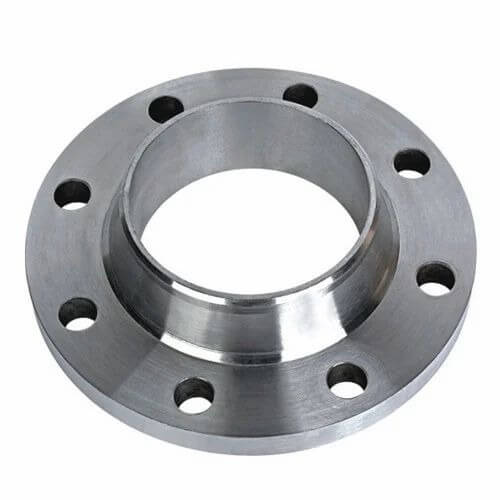ASTM A105 is a standard specification issued by the American Society for Testing and Materials (ASTM) that defines the requirements for forged carbon steel piping components. Among the most widely used products under this specification are ASTM A105 flanges. These flanges are essential components in piping systems across industries such as oil and gas, petrochemical, power generation, and marine sectors. They are specifically designed for ambient and high-temperature service in pressure systems.
Key Features of ASTM A105 Flanges
- Material Composition
- ASTM A105 flanges are made from forged carbon steel with a chemical composition that typically includes:
- Carbon: ≤ 0.35%
- Manganese: 0.60–1.05%
- Phosphorus: ≤ 0.035%
- Sulfur: ≤ 0.040%
- Silicon: 0.10–0.35%
- This composition ensures good machinability, toughness, and weldability.
- Mechanical Properties
- Tensile Strength: ≥ 485 MPa (70 ksi)
- Yield Strength: ≥ 250 MPa (36 ksi)
- Elongation: ≥ 22%
- Hardness: ≤ 187 HBW (Brinell Hardness)
- Temperature Suitability
- These flanges are suitable for use in temperatures ranging from ambient to high temperatures, typically up to 593°C (1100°F).
- Forging Process
- ASTM A105 flanges are typically forged to enhance their mechanical strength and durability. Forging refines the grain structure and increases impact resistance.
Types of ASTM A105 Flanges
ASTM A105 flanges come in a wide range of types, each designed for specific applications:
- Weld Neck Flange (WNRF): Suitable for high-pressure applications; provides reinforcement at the flange-pipe junction.
- Slip-On Flange (SORF): Easy to install and weld; used for low-pressure and non-critical services.
- Blind Flange (BLRF): Used to block off pipeline ends, valves, or pressure vessel openings.
- Socket Weld Flange (SWRF): Best for small-diameter, high-pressure piping.
- Threaded Flange (THRF): Screwed onto pipes without welding; used in low-pressure, non-vibration applications.
- Lap Joint Flange (LJRF): Used with stub ends for systems requiring frequent dismantling.
- Long Weld Neck Flange (LWNRF): Extended neck for reinforcement in high-pressure applications.
Pressure Ratings
ASTM A105 flanges are manufactured according to ANSI/ASME B16.5 and B16.47 standards and are available in pressure classes:
- Class 150
- Class 300
- Class 600
- Class 900
- Class 1500
- Class 2500
These pressure ratings determine the maximum allowable pressure the flange can withstand at different temperatures.
Applications of ASTM A105 Flanges
Due to their strength and versatility, ASTM A105 flanges are used in:
- Oil and Gas Industry
- Petrochemical Plants
- Power Plants
- Refineries
- Water Treatment Facilities
- Marine Applications
- Chemical Processing
Advantages of ASTM A105 Flanges
- Cost-Effective: Compared to alloy and stainless steel flanges, A105 carbon steel flanges are economical.
- High Strength: Excellent mechanical properties make them ideal for high-stress applications.
- Versatile Usage: Can be used in a variety of temperature and pressure environments.
- Weldability: Easily weldable with common welding practices.
- Availability: Widely available in standard sizes and pressure classes.
Testing & Certification
ASTM A105 flanges undergo rigorous quality control and testing to ensure compliance with international standards. These include:
- Hydrostatic Testing
- Ultrasonic Testing (UT)
- Radiographic Testing (RT)
- Positive Material Identification (PMI)
- Hardness Testing
- Destructive and Non-destructive Testing (NDT)
All flanges are supplied with certifications like EN 10204 3.1 or 3.2 as per client or project requirements.
Conclusion
ASTM A105 flanges represent a critical component in industrial piping systems, offering high performance, durability, and reliability. Their ability to withstand high pressure and temperature, coupled with cost-efficiency and ease of availability, makes them a preferred choice across various engineering and industrial sectors. Whether for maintenance, new installations, or system upgrades, ASTM A105 flanges provide a dependable solution for robust piping connectivity.






Comments